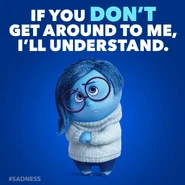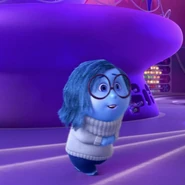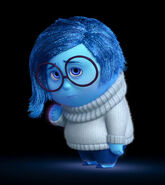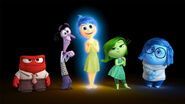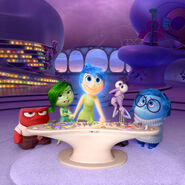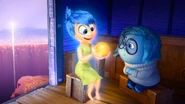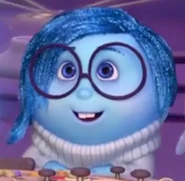Gray Catbird (talk | contribs) No edit summary Tags: Visual edit apiedit |
mNo edit summary Tag: sourceedit |
||
| Line 1: | Line 1: | ||
| − | {{Character|image=Io Sadness standard2.jpg|performer=[[Phyllis Smith]]|appear=''[[Inside Out]]''}} |
+ | {{Character|image=Io Sadness standard2.jpg|performer=[[Phyllis Smith]]|appear=''[[Inside Out]]''}} |
| + | [[File:Meet Sadness - Inside Out|thumb|300px]] |
||
'''Sadness''' is a character of ''[[Inside Out]]''. She is one of the five emotions inside the [[Riley's Mind|mind]] of [[Riley]]. According to an interview with [[Phyllis Smith]], Sadness is the voice of reason: when [[Joy]] has an idea, she'll try and drag her down. She appears to be depressive all the time. |
'''Sadness''' is a character of ''[[Inside Out]]''. She is one of the five emotions inside the [[Riley's Mind|mind]] of [[Riley]]. According to an interview with [[Phyllis Smith]], Sadness is the voice of reason: when [[Joy]] has an idea, she'll try and drag her down. She appears to be depressive all the time. |
||
Revision as of 18:00, 21 May 2015

Meet Sadness - Inside Out
Sadness is a character of Inside Out. She is one of the five emotions inside the mind of Riley. According to an interview with Phyllis Smith, Sadness is the voice of reason: when Joy has an idea, she'll try and drag her down. She appears to be depressive all the time.
Official Bio
"None of the other Emotions really understand what Sadness’s role is. Sadness would love to be more optimistic and helpful in keeping Riley happy, but she finds it so hard to be positive. Sometimes it seems like the best thing to do is just lie on the floor and have a good cry."[1]
Appearance
Sadness has blue skin, hair and eyes. She wears has a white sweater, big round glasses, and blue pants and slippers.
Trivia
- Sadness could resemble a nerd, with her thinking she doesn't fit in, and with her big round glasses and sweater.
- Even though Sadness is mostly seen as mournful, there are several occasions when she is seen smiling proving that emotions can express more feelings than their own representation.
Gallery
Sadness as seen at the end of the Inside Out Teaser Trailer


